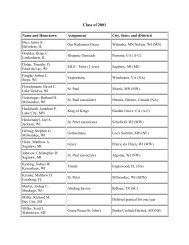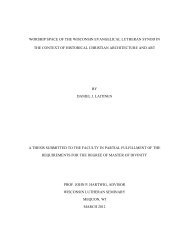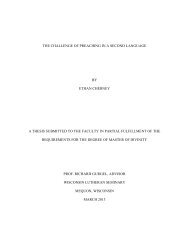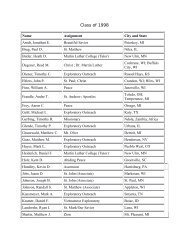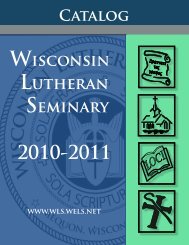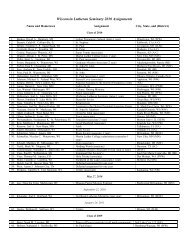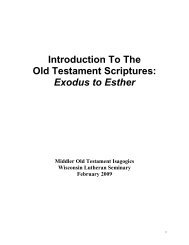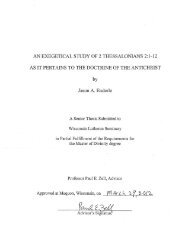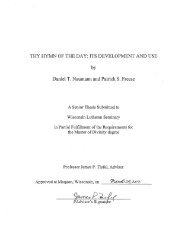Untitled - Wisconsin Lutheran Seminary - WELS
Untitled - Wisconsin Lutheran Seminary - WELS
Untitled - Wisconsin Lutheran Seminary - WELS
Create successful ePaper yourself
Turn your PDF publications into a flip-book with our unique Google optimized e-Paper software.
former idea is that the “now” goes together with a word following it in the sentence. One option<br />
is to take it with the verb οἴδατε, so as to carry the sense that the readers “now (already) know”<br />
the thing restraining. Another option presented is to take it with the participle τὸ κατέχον, thus<br />
implying that they know the thing that is “now (currently) restraining” him. This is a moot point<br />
since there is not a definite answer. The focus is simply this: because of Paul’s ministry among<br />
them they knew this force. Paul spends no further time describing it to them. Keeping in mind<br />
that he wrote this letter to give them comfort and assurance, Paul simply asks them to recall what<br />
they already knew and use it to support his words here.<br />
From the restraining force<br />
After Paul directs their attention to what he had told them while he was with them, he<br />
encourages them to recall what they had learned from him. He uses οἴδατε, the perfect active<br />
indicative form of the verb οἶδα, which in its simplest definition means “to know, to have<br />
information about something.” One must assume that Paul’s original readers had been told<br />
previously by Paul because no further description is given in the letter. It was this knowledge of<br />
the direct object, the articularized accusative participle, τὸ κατέχον, that he brought to the<br />
forefront of their minds. τὸ κατέχον is from κατέχω, meaning “to prevent, hinder, or restrain.”<br />
This force is the thing that is preventing this “man of lawlessness” from being revealed. The<br />
participle is here found in the neuter gender, yet Paul uses the masculine gender in the following<br />
verse to describe the same force. Wanamaker in his commentary comes to the conclusion that<br />
“Timothy, as the bearer of the letter, would have explained anything not fully understood when<br />
he brought the letter to Thessalonica.” 62<br />
While the Thessalonians would have had the oral training and teaching in regard to this<br />
matter, present-day readers have nothing more than Paul’s letters, which give no additional<br />
description of this restraining force. D.G. Barnhouse interprets “temple of God” in verse four as<br />
the Holy Spirit dwelling in us and says: “The believer’s body is the temple of the Spirit of God.<br />
Put all believers together then, with the Holy Spirit indwelling each of us, and you have a<br />
formidable restraining force. Now, it’s true, the church of Jesus Christ could be more bold in its<br />
62 Charles A. Wanamaker, The Epistles to the Thessalonians: A Commentary on the Greek Text (Grand<br />
Rapids, MI: Wm. B. Eerdmans Publishing Co., 1990), 250.<br />
32




